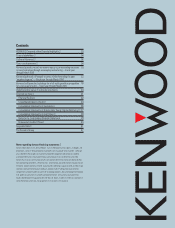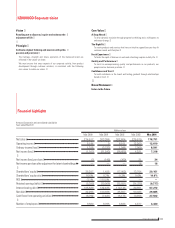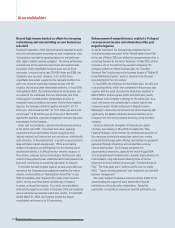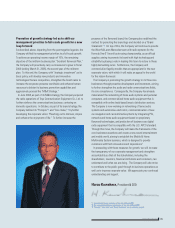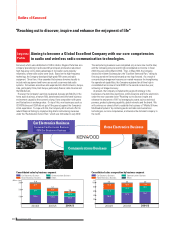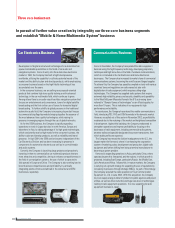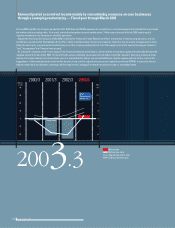Kenwood 2004 Annual Report Download - page 4
Download and view the complete annual report
Please find page 4 of the 2004 Kenwood annual report below. You can navigate through the pages in the report by either clicking on the pages listed below, or by using the keyword search tool below to find specific information within the annual report.
To our stakeholders
Record high income booked as efforts for sweeping
restructuring and concentrating on core businesses
take hold
Kenwood Corporation, which had continuously expanded its audio
and radio communications businesses as core competences since
its foundation, had kept its operating balance in the black even
after Japan's bubble economy collapsed. The strong performance
was achieved as the automotive electronics and wireless radio
businesses offset unprofitable business areas such as home
electronics, a matured sector, and CD-ROM drives and GSM, the
Company's new business. However, it is true that these
unprofitable businesses weighed on the Company's bottom line,
and in the course of promoting measures to cope with the
situation, the balance sheet deteriorated markedly. In fiscal 2000
(ending March 2001), the Company booked an extraordinary loss
as a result of the withdrawal from new businesses, and in the
following year it posted another extraordinary loss due to
evaluation losses as deflation worsened. Hurt by these negative
legacies, the Company stated its negative net worth*1 at 17.0
billion yen, interest-bearing debt*1 at 110.1 billion yen and a loss
carryforward*2 of 44.6 billion yen as of the end of March 2002.
Against this backdrop, corporate management restructuring was a
pressing task for the Company.
Under such circumstances, I assumed the Kenwood presidency
at the end of June 2002. There have been many Japanese
corporations whose performance became sluggish as their
industry matured, but I believe that such an industry is intrinsically
quite attractive. In the matured field, no growth is expected, but a
large and stable market already exists. While an increasing
number of companies are withdrawing from this industry due to
declined profitability, it is difficult for new entrants, because, in
this industry, resources such as technologies, facilities and sales
networks have generally been established and brand presence has
been built, constituting an extremely high barrier for entrants.
To eliminate the past negative legacies as soon as possible and
restructure the Company by leveraging the benefits of a mature
industry, we formulated our "Revitalization Action Plan" in July
2002 (immediately after I became CEO), under which the entire
staff is striving to achieve drastic restructuring of finances,
business, costs and the industry. As a result, we were able to
eliminate the negative net worth in December 2002 and completed
various restructuring measures within nine months. In fiscal 2002
(ended March 31, 2003), the Company booked the largest
consolidated net income in its 57-year history.
Enhancement of competitiveness enabled a V-shaped
recovery in net income and elimination of the past
negative legacies
As earlier mentioned, the Company had completed various
restructuring measures as part of the "Revitalization Action Plan"
by the end of March 2003, and shifted its management priorities to
a new leap forward as the reborn Kenwood. In May 2003, aiming
to become one of the world's truly excellent companies, the
Company drafted its midterm business plan, the "Excellent
Kenwood Plan" that focuses on the business domain of "Mobile &
Home Multimedia System," which is expected to be the most
promising field in the 21st century."
In fiscal 2003, the initial year for the midterm plan, the effects of
restructuring efforts, which were completed in the previous year,
together with the result of production innovations launched in
March 2003 to further improve profits and cash flows, clearly
contributed to the Company's earnings for the whole year. As a
result, net income rose substantially to a record high for two
consecutive years, literally achieving a V-shaped recovery.
Managing to reduce loss carryforward and interest-bearing debt
significantly, the balance sheet also became healthier, as the
Company took its first step towards becoming a truly excellent
company.
Aiming to drastically strengthen its financial and capital
structure, the Company in May 2004 formulated the "New
Financial Strategy," which involves the simultaneous execution of
four measures: entirely eliminating loss carried over; retiring
preferred stock through public offering; terminating the repayment
agreement through refinancing; and substantially reducing
interest-bearing debt. The Company completed this
unprecedented scheme (for Japan) by the end of August 2004.
This accomplishment translated into a dramatic improvement in its
financial basis, a big step toward attaining three of the four
objectives set in the midterm business plan: "Excellent Kenwood
Plan." The three goals are to "achieve a 20% return on equity
(ROE)," "resume dividend payments" and "implement zero net-debt
business management."
We could complete the above-mentioned scheme thanks to the
understanding and support of every shareholder, financial
institution as well as the other stakeholders. Taking this
opportunity, I would like to express my heartfelt gratitude to you.
Annual Report 2004
04


